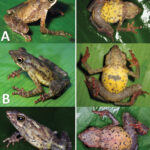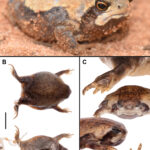- Atelopus famelicus: Rediscovering an Enigmatic Jewel of the Amazon
- Taxonomy and Classification of Atelopus famelicus
- Natural Habitat: Exploring the Verdant Home of Atelopus famelicus
- Physical Characteristics: Beauty Born from Survival
- Behavior and Life Cycle: Rhythm of the Cloud Forest
- Ecological Role: Guardians of Biodiversity
- Threats and Conservation Status: An Urgent Call to Action
- Cultural and Scientific Significance: Beyond the Scientific Realm
- Conclusion: Protecting a Living Treasure
Atelopus famelicus: Rediscovering an Enigmatic Jewel of the Amazon#
Within the thick foliage and misty slopes of Colombia’s lush montane forests, hidden among layers of shimmering moss and leaves glistening from perpetual rainfall, lives a small yet extraordinary amphibian—the Atelopus famelicus. Known to locals and scientists alike as the “hungry harlequin toad,” this elusive frog has piqued the curiosity of researchers due to its striking appearance, enigmatic behaviors, and, unfortunately, concerning dwindling numbers. Although rarely glimpsed and poorly understood for decades, this curious species serves as a poignant reflection of the fragile yet vibrant ecosystems it inhabits.
The Atelopus famelicus, characterized by brilliant yellows, greens, and stark black patterns adorning its sleek amphibian physique, is more than just a visual jewel of the forest. It is a living testament to the delicate balance of ecological connections that dictate the health and vitality of its tropical mountain home. Beyond its striking patterns and bright colors lies a species whose story invites us to explore the depths of Colombia’s montane ecosystems, the rich biodiversity within, and the delicate threads tying them to our global environmental health.
Taxonomy and Classification of Atelopus famelicus#
The Atelopus famelicus belongs to the Bufonidae family, a diverse group commonly known as the true toads. Within this family, the genus Atelopus—colloquially called the harlequin toads—is renowned for its vibrantly-colored and visually arresting members. Atelopus species are often small, diurnal amphibians, frequently adorned with contrasting color schemes that serve as stark warnings to potential predators of their potent toxins.
First described scientifically by Rivero and Morales in 1995, Atelopus famelicus was immediately recognized for its distinctive characteristics, making it easy for herpetologists to distinguish it from other closely related species. Genetic studies further confirm its unique evolutionary lineage within the genus, signifying a distinct evolutionary history shaped by its specialized environmental niche.
Natural Habitat: Exploring the Verdant Home of Atelopus famelicus#
Situated within the cloud forests along Colombia’s eastern Andean slopes, the natural habitat of Atelopus famelicus epitomizes a biologically rich and climatically sensitive ecosystem. Occupying a narrow altitudinal range between 1,000 and 1,700 meters, the frog thrives amidst a moistened landscape perpetually cloaked in swirling mist and interspersed small streams and rushing brooks.
A World of Mist and Moss#
Within their realm, the forest canopy filters sunlight into dappled patterns that shimmer upon damp leaf litter, fallen logs, and the quantifiable carpets of moss adorning bark and rock surfaces alike. This lush, humid environment is crucial, offering the amphibians necessary moisture levels for their highly permeable skin. Additionally, the mountain streams supplying fresh, oxygen-rich waters are indispensable for breeding and structuring their delicate life cycles.
The microhabitats favored by Atelopus famelicus consist predominantly of shady understory vegetation adjoining gushing mountain streams—a microcosmic paradise providing hiding spaces, hunting grounds, and sheltered corridors. As each dawn emerges, veiled in mist, the frogs begin their meticulous daily journeys; each leaf carefully traversed, each crevice cautiously explored.
Physical Characteristics: Beauty Born from Survival#
The Atelopus famelicus is visually arresting in its coloration, showcasing hues characteristic of its genus. Averaging from merely 2.5 to 4 centimeters in length, their petite bodies feature smooth skin accentuated by vivid yellow-green shades interspersed with contrasting black bars and blotches. Every individual possesses a unique pattern—much like fingerprints in humans—that herpetologists utilize for identification and monitoring.
Colors of Warning and Camouflage#
The frog’s vibrant colors serve dual purposes. Firstly, the vivid hues act as aposematic signals, advertising their potent toxins. Secreted through the skin, these toxins discourage predation, deterring would-be predators such as birds and snakes. Secondly, the blend of vivid green, yellow, and black patterns, complemented by the dappled lighting and shifting shadows of their habitat, strategically provides camouflage from predators who may have developed resistance to such toxins.
The elongated limbs, adept at leaping across greenery and navigating intricate moss-laden terrains, combined with their slender physique, have granted this frog remarkable agility and graceful movement, essential for surviving in its competitive habitat.
Behavior and Life Cycle: Rhythm of the Cloud Forest#
The daily life of Atelopus famelicus revolves around an elegant, rhythmic integration into the natural cycles of its forest home. As a predominantly diurnal species, these frogs spend daylight hours foraging cautiously across dense leaf litter and forging careful routes along stream banks.
A Taste for Small Prey#
The Atelopus famelicus is an opportunistic predator, feeding primarily on the abundant wealth of insects crawling through the humid forest layer—ants, beetles, and tiny arachnids constitute an essential part of their diet. Their patient and methodical movements ensure their prey rarely detect their presence, allowing the frog to strike quickly with its sticky, capable tongue.
Intimate Courtship Along Babbling Streams#
The breeding behaviors of Atelopus famelicus fascinate observers fortunate enough to witness them. Males take their territorial calls seriously, announcing their presence with a soft yet persistent trill that ripples softly through the spray-soaked forest air. Females, drawn to these melodious advertisements, carefully select mates based on vocal performance, territory quality, and perhaps genetic compatibility.
Once united, pairs lay their gelatinous egg clutches among rocks and vegetation anchored within the pristine, bubbly waters. This stage is particularly vulnerable, as tadpoles depend entirely upon the stability and cleanliness of their aquatic nurseries.
Ecological Role: Guardians of Biodiversity#
Occupying vital ecological niches within their cloud-forest habitats, Atelopus famelicus contributes significantly to biodiversity maintenance. The frog acts simultaneously as predator and prey—a critical component of trophic stability. Predating on insects, it helps regulate populations, preventing outbreaks of certain forest pests. Conversely, the frogs serve as essential prey items for specialized predators possessing tolerances to amphibian toxins, thus maintaining a balanced predator-prey dynamic within the ecosystem.
Moreover, due to their permeable skin and complex life cycles dependent on both terrestrial and aquatic environments, Atelopus famelicus is highly sensitive to environmental change, making it an effective indicator species and ecological sentinel.
Threats and Conservation Status: An Urgent Call to Action#
Sadly, the story of Atelopus famelicus is not without threat and uncertainty. Like many of its relatives within the harlequin toad genus, this species suffers population declines primarily due to habitat loss, climate change disruptions, and exposure to pathogens such as the devastating chytrid fungus (Batrachochytrium dendrobatidis). Consequently, the IUCN categorizes this frog as Critically Endangered, demanding immediate conservation action.
Scientific teams and local conservationists are diligently working towards preserving remaining frog populations. Efforts include habitat protection, restoration, monitoring projects, and captive breeding programs aimed at ensuring its survival. Education initiatives aim not only at raising public awareness but also empowering local communities as protectors and stewards of these extraordinary amphibians and their habitats.
Cultural and Scientific Significance: Beyond the Scientific Realm#
While primarily scientific curiosity motivates studies into Atelopus famelicus, this species also embodies deeper cultural resonance. Indigenous communities within the Colombian Andes recognize amphibians as vital components of natural systems, often symbolic intermediaries between land and water, earth and sky, signifying ecological balance and environmental health.
Scientifically, research on this species sheds precious light on many broader ecological dynamics, including environmental monitoring, climate impacts, and pathogen response. Their struggles highlight urgent messages about global health, beckoning humans to reconsider their relationships with ecosystems worldwide.
Conclusion: Protecting a Living Treasure#
The enigmatic Atelopus famelicus offers humanity a vital chance to reflect upon our responsibilities toward nature. Every vibrant pattern, graceful leap, and gentle mating trill constitutes a stark reminder of our duty—not just to study, but – perhaps even more importantly – to preserve and nurture the fragile wildernesses we often take for granted. By supporting global and local amphibian conservation efforts, we help safeguard Atelopus famelicus and ensure future generations experience the wonder of this small yet spectacular treasure of the Andes’ misty forests.







